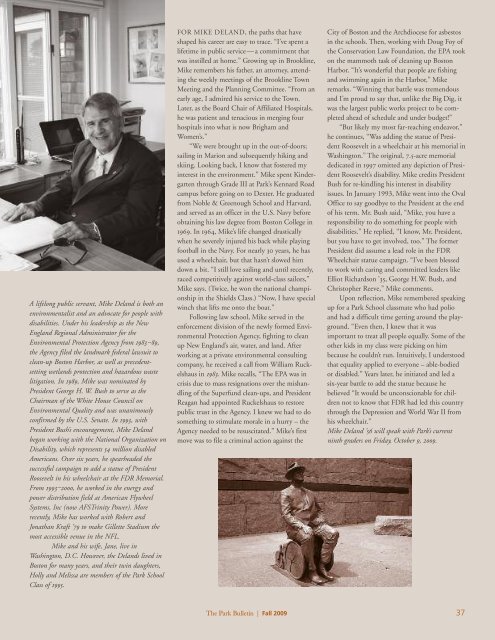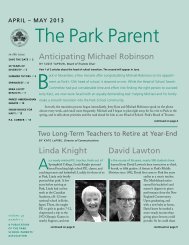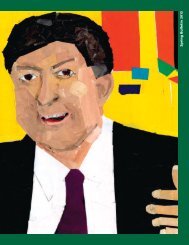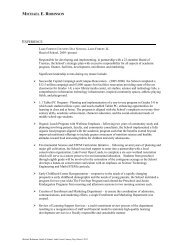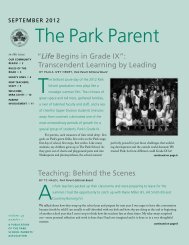⢠ParkBulletinCover - The Park School
⢠ParkBulletinCover - The Park School
⢠ParkBulletinCover - The Park School
You also want an ePaper? Increase the reach of your titles
YUMPU automatically turns print PDFs into web optimized ePapers that Google loves.
A lifelong public servant, Mike Deland is both an<br />
environmentalist and an advocate for people with<br />
disabilities. Under his leadership as the New<br />
England Regional Administrator for the<br />
Environmental Protection Agency from 1983‒89,<br />
the Agency filed the landmark federal lawsuit to<br />
clean-up Boston Harbor, as well as precedentsetting<br />
wetlands protection and hazardous waste<br />
litigation. In 1989, Mike was nominated by<br />
President George H. W. Bush to serve as the<br />
Chairman of the White House Council on<br />
Environmental Quality and was unanimously<br />
confirmed by the U.S. Senate. In 1993, with<br />
President Bush’s encouragement, Mike Deland<br />
began working with the National Organization on<br />
Disability, which represents 54 million disabled<br />
Americans. Over six years, he spearheaded the<br />
successful campaign to add a statue of President<br />
Roosevelt in his wheelchair at the FDR Memorial.<br />
From 1993‒2000, he worked in the energy and<br />
power distribution field at American Flywheel<br />
Systems, Inc (now AFSTrinity Power). More<br />
recently, Mike has worked with Robert and<br />
Jonathan Kraft ’79 to make Gillette Stadium the<br />
most accessible venue in the NFL.<br />
Mike and his wife, Jane, live in<br />
Washington, D.C. However, the Delands lived in<br />
Boston for many years, and their twin daughters,<br />
Holly and Melissa are members of the <strong>Park</strong> <strong>School</strong><br />
Class of 1995.<br />
FOR MIKE DELAND, the paths that have<br />
shaped his career are easy to trace. “I’ve spent a<br />
lifetime in public service—a commitment that<br />
was instilled at home.” Growing up in Brookline,<br />
Mike remembers his father, an attorney, attending<br />
the weekly meetings of the Brookline Town<br />
Meeting and the Planning Committee. “From an<br />
early age, I admired his service to the Town.<br />
Later, as the Board Chair of Affiliated Hospitals,<br />
he was patient and tenacious in merging four<br />
hospitals into what is now Brigham and<br />
Women’s.”<br />
“We were brought up in the out-of-doors;<br />
sailing in Marion and subsequently hiking and<br />
skiing. Looking back, I know that fostered my<br />
interest in the environment.” Mike spent Kindergarten<br />
through Grade III at <strong>Park</strong>’s Kennard Road<br />
campus before going on to Dexter. He graduated<br />
from Noble & Greenough <strong>School</strong> and Harvard,<br />
and served as an officer in the U.S. Navy before<br />
obtaining his law degree from Boston College in<br />
1969. In 1964, Mike’s life changed drastically<br />
when he severely injured his back while playing<br />
football in the Navy. For nearly 30 years, he has<br />
used a wheelchair, but that hasn’t slowed him<br />
down a bit. “I still love sailing and until recently,<br />
raced competitively against world-class sailors,”<br />
Mike says. (Twice, he won the national championship<br />
in the Shields Class.) “Now, I have special<br />
winch that lifts me onto the boat.”<br />
Following law school, Mike served in the<br />
enforcement division of the newly formed Environmental<br />
Protection Agency, fighting to clean<br />
up New England’s air, water, and land. After<br />
working at a private environmental consulting<br />
company, he received a call from William Ruckelshaus<br />
in 1983. Mike recalls, “<strong>The</strong> EPA was in<br />
crisis due to mass resignations over the mishandling<br />
of the Superfund clean-ups, and President<br />
Reagan had appointed Ruckelshaus to restore<br />
public trust in the Agency. I knew we had to do<br />
something to stimulate morale in a hurry – the<br />
Agency needed to be resuscitated.” Mike’s first<br />
move was to file a criminal action against the<br />
City of Boston and the Archdiocese for asbestos<br />
in the schools. <strong>The</strong>n, working with Doug Foy of<br />
the Conservation Law Foundation, the EPA took<br />
on the mammoth task of cleaning up Boston<br />
Harbor. “It’s wonderful that people are fishing<br />
and swimming again in the Harbor,” Mike<br />
remarks. “Winning that battle was tremendous<br />
and I’m proud to say that, unlike the Big Dig, it<br />
was the largest public works project to be completed<br />
ahead of schedule and under budget!”<br />
“But likely my most far-reaching endeavor,”<br />
he continues, “Was adding the statue of President<br />
Roosevelt in a wheelchair at his memorial in<br />
Washington.” <strong>The</strong> original, 7.5-acre memorial<br />
dedicated in 1997 omitted any depiction of President<br />
Roosevelt’s disability. Mike credits President<br />
Bush for re-kindling his interest in disability<br />
issues. In January 1993, Mike went into the Oval<br />
Office to say goodbye to the President at the end<br />
of his term. Mr. Bush said, “Mike, you have a<br />
responsibility to do something for people with<br />
disabilities.” He replied, “I know, Mr. President,<br />
but you have to get involved, too.” <strong>The</strong> former<br />
President did assume a lead role in the FDR<br />
Wheelchair statue campaign. “I’ve been blessed<br />
to work with caring and committed leaders like<br />
Elliot Richardson ’35, George H.W. Bush, and<br />
Christopher Reeve,” Mike comments.<br />
Upon reflection, Mike remembered speaking<br />
up for a <strong>Park</strong> <strong>School</strong> classmate who had polio<br />
and had a difficult time getting around the playground.<br />
“Even then, I knew that it was<br />
important to treat all people equally. Some of the<br />
other kids in my class were picking on him<br />
because he couldn’t run. Intuitively, I understood<br />
that equality applied to everyone – able-bodied<br />
or disabled.” Years later, he initiated and led a<br />
six-year battle to add the statue because he<br />
believed “It would be unconscionable for children<br />
not to know that FDR had led this country<br />
through the Depression and World War II from<br />
his wheelchair.”<br />
Mike Deland ’56 will speak with <strong>Park</strong>’s current<br />
ninth graders on Friday, October 9, 2009.<br />
<strong>The</strong> <strong>Park</strong> Bulletin | Fall 2009 37


